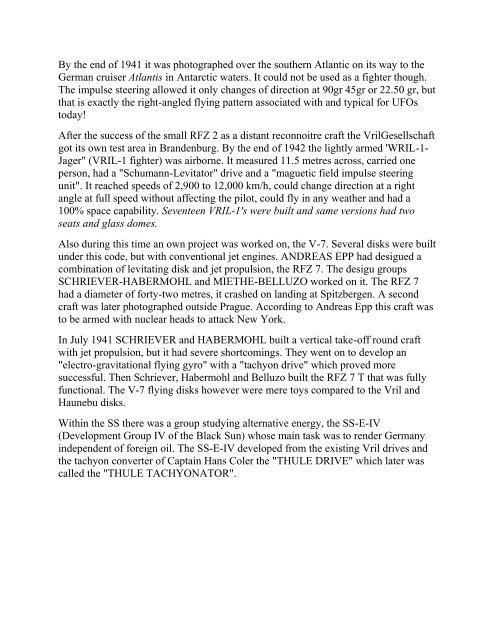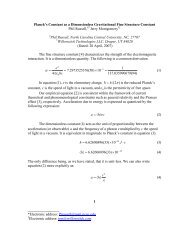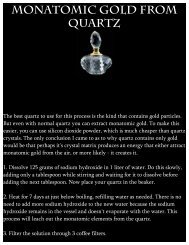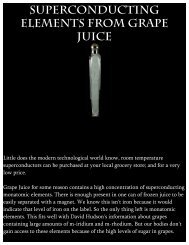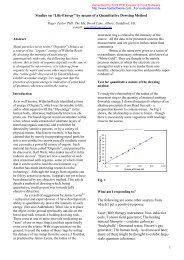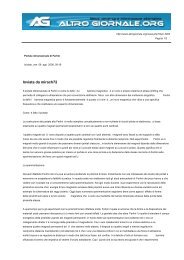Viktor Schauberger
Viktor Schauberger
Viktor Schauberger
You also want an ePaper? Increase the reach of your titles
YUMPU automatically turns print PDFs into web optimized ePapers that Google loves.
By the end of 1941 it was photographed over the southern Atlantic on its way to the<br />
German cruiser Atlantis in Antarctic waters. It could not be used as a fighter though.<br />
The impulse steering allowed it only changes of direction at 90gr 45gr or 22.50 gr, but<br />
that is exactly the right-angled flying pattern associated with and typical for UFOs<br />
today!<br />
After the success of the small RFZ 2 as a distant reconnoitre craft the VrilGesellschaft<br />
got its own test area in Brandenburg. By the end of 1942 the lightly armed 'WRIL-1-<br />
Jager" (VRIL-1 fighter) was airborne. It measured 11.5 metres across, carried one<br />
person, had a "Schumann-Levitator" drive and a "maguetic field impulse steering<br />
unit". It reached speeds of 2,900 to 12,000 km/h, could change direction at a right<br />
angle at full speed without affecting the pilot, could fly in any weather and had a<br />
100% space capability. Seventeen VRIL-1's were built and same versions had two<br />
seats and glass domes.<br />
Also during this time an own project was worked on, the V-7. Several disks were built<br />
under this code, but with conventional jet engines. ANDREAS EPP had desigued a<br />
combination of levitating disk and jet propulsion, the RFZ 7. The desigu groups<br />
SCHRIEVER-HABERMOHL and MIETHE-BELLUZO worked on it. The RFZ 7<br />
had a diameter of forty-two metres, it crashed on landing at Spitzbergen. A second<br />
craft was later photographed outside Prague. According to Andreas Epp this craft was<br />
to be armed with nuclear heads to attack New York.<br />
In July 1941 SCHRIEVER and HABERMOHL built a vertical take-off round craft<br />
with jet propulsion, but it had severe shortcomings. They went on to develop an<br />
"electro-gravitational flying gyro" with a "tachyon drive" which proved more<br />
successful. Then Schriever, Habermohl and Belluzo built the RFZ 7 T that was fully<br />
functional. The V-7 flying disks however were mere toys compared to the Vril and<br />
Haunebu disks.<br />
Within the SS there was a group studying alternative energy, the SS-E-IV<br />
(Development Group IV of the Black Sun) whose main task was to render Germany<br />
independent of foreign oil. The SS-E-IV developed from the existing Vril drives and<br />
the tachyon converter of Captain Hans Coler the "THULE DRIVE" which later was<br />
called the "THULE TACHYONATOR".


